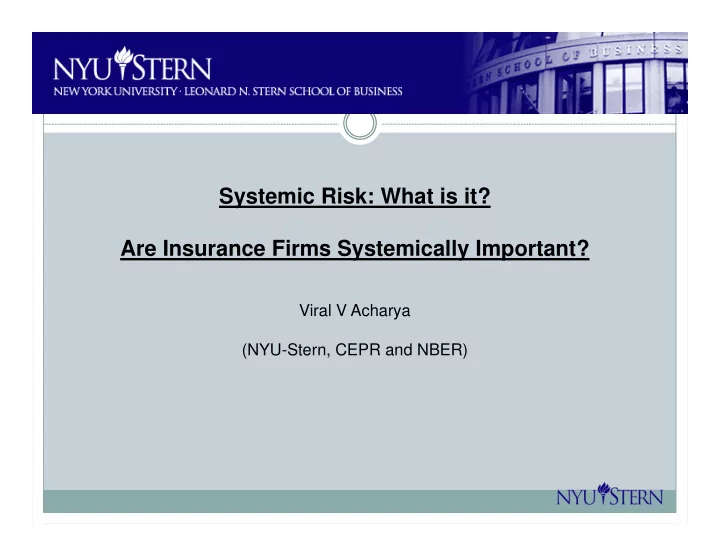

Systemic Risk: What is it? Are Insurance Firms Systemically Important? Viral V Acharya (NYU-Stern, CEPR and NBER)
What is “system ic risk”? Micro-prudential view: Contagion Failure of an entity leads to distress or failures of others Too-big-to-fail institutions Regulate TBTF better The Dodd-Frank Act is primarily the “micro-prudential view” Systemically Important Financial Institutions (SIFIs) Regulate SIFIs better
What is “system ic risk”? Macro-prudential view: (Diamond-Dybvig + Shleifer-Vishny) Common factor exposures Runs Several entities fail together as Short-term creditors demand immediacy Against long-term assets But the system has limited capacity (capital?) to provide immediacy The micro-prudential and macro-prudential views are not necessarily mutually exclusive
Two views lead to different reform s I. Micro-prudential view: Design “top-down” bankruptcy procedure for failing SIFI Example: Dodd-Frank Act, contingent capital, bail-in II. Macro-prudential view: Design “bottom-up” resolution at market-level for systemically important assets & liabilities (SIALs) Example: Derivatives/ Repo clearinghouses, LOLR
System ic risk need NOT be about SIFIs There have indeed been runs on SIFIs in the past But a number of runs in the 2007-09 crisis were also runs on relatively smaller shadow banks (such as hedge funds, conduits and SIVs and money-market funds) Failures of collection of smaller lenders has historically led to significant crises such as S&L crisis in the United States and the current Spanish woes due to Cajas
ABCP “run” (Acharya, Schnabl and Suarez) 1300 1200 ABCP outstanding 1100 1000 Billion 900 800 700 600 500 1/ 7/ 2004 1/ 7/ 2005 1/ 7/ 2006 1/ 7/ 2007 1/ 7/ 2008 1/ 7/ 2009
ABCP “run” (Acharya, Schnabl and Suarez) 160 BNP Paribas announces that it cannot value 140 mortgage assets in some money funds 120 (Aug 9, 2007) Basis points 100 80 60 40 20 0 -20
ABCP “run” (Acharya, Schnabl and Suarez)
Im m ediacy: a source of system ic risk Prior to fiat money, there was often a shortage of money Solution: Commercial bank clearinghouses Suspend conversion of immediacy, adopt joint liability Problem: If there isn’t adequate capital with joint liability providers, runs may not get stemmed In extremis, bank runs can morph into sovereign crisis (Ireland) Modern-day runs: Resolution difficulties stem from inability to suspend conversion of immediacy LOLR takes on significant asset risk while providing immediacy Safe-harbor provisions may require systemic exception
What about contagion? Macro-prudential view: Contagion can amplify problems provided rest of the system cannot Withstand the distress or failures of others, e.g., because it is under- capitalized too due to a common shock (AIG FP failure) Re-intermediate the liquidated assets of distressed firms (Lehman) Contagion can arise w ithout inter-connections Information contagion Learning about common assets (Great Depression “runs”) Learning about regulatory policy (Greece, Cyprus interventions) Flow of funds or re-intermediation contagion Insurance firms withdraw from bonds inducing LC runs on banks Corporations draw down money-market deposits affecting banks…
Top 5 Bank and Bank Holding Companies Ticker Asset SRISK GICS Subindustry BAC Bank Of America 93066.6867 Other Diversified Financial Services JPM JP Morgan Chase 79993.74914 Other Diversified Financial Services C Citigroup 57388.01611 Other Diversified Financial Services MS Morgan Stanley 37679.0014 Investment Banking & Brokerage GS Goldman Sachs 33573.11695 Investment Banking & Brokerage Top 5 Insurers Ticker Asset SRISK GICS Subindustry MET MetLife 40686.07964 Life & Health Insurance PRU Prudential Financial 40289.71961 Life & Health Insurance HIG Hartford Financial Services 16146.21157 Multi ‐ line Insurance LNC Lincoln National Corp 13665.86848 Life & Health Insurance PFG Principal Financial Group 9738.121129 Life & Health Insurance
NYU Stern Systemic Risk Rankings at http://vlab.stern.nyu.edu/
60000 SRISK: Capital shortfall in case of 40% market correction 50000 40000 HIG LNC 30000 MET PFG PRU 20000 10000 0 1/ 3/ 2006 1/ 3/ 2007 1/ 3/ 2008 1/ 3/ 2009 1/ 3/ 2010 1/ 3/ 2011 1/ 3/ 2012 1/ 3/ 2013
0.25 MES: %Loss of market value in case of 2% market correction 0.2 0.15 HIG LNC MET PFG PRU 0.1 0.05 0 1/ 3/ 2006 1/ 3/ 2007 1/ 3/ 2008 1/ 3/ 2009 1/ 3/ 2010 1/ 3/ 2011 1/ 3/ 2012 1/ 3/ 2013
250 LVG: (Book Liabilities + Mkt Equity) / Mkt Equity 200 150 HIG LNC MET PFG PRU 100 50 0 1/ 3/ 2006 1/ 3/ 2007 1/ 3/ 2008 1/ 3/ 2009 1/ 3/ 2010 1/ 3/ 2011 1/ 3/ 2012 1/ 3/ 2013
180000 SRISK: Capital shortfall in case of 40% market correction 160000 140000 120000 BAC 100000 C GS JPM 80000 MS 60000 40000 20000 0 1/ 3/ 2006 1/ 3/ 2007 1/ 3/ 2008 1/ 3/ 2009 1/ 3/ 2010 1/ 3/ 2011 1/ 3/ 2012 1/ 3/ 2013
0.25 MES: %Loss of market value in case of 2% market correction 0.2 0.15 BAC C GS JPM MS 0.1 0.05 0 1/ 3/ 2006 1/ 3/ 2007 1/ 3/ 2008 1/ 3/ 2009 1/ 3/ 2010 1/ 3/ 2011 1/ 3/ 2012 1/ 3/ 2013
350 MES: %Loss of market value in case of 2% market correction 300 250 200 BAC C GS JPM 150 MS 100 50 0 1/ 3/ 2006 1/ 3/ 2007 1/ 3/ 2008 1/ 3/ 2009 1/ 3/ 2010 1/ 3/ 2011 1/ 3/ 2012 1/ 3/ 2013
Open questions (for Insurance Firm s!) Why did market values of insurance firms collapse so much in Fall of 2008? Why are downside risk or beta estimates of insurance firms as high as those of banks and bank holding companies? Why were insurance firms owning banks, making guaranteed financial products, selling CDS, etc.?
Open questions (for Insurance Firm s!) If insurance firm liabilities are more stable, won’t they take advantage of that and keep less equity on balance- sheet a priori? When market value of insurance firms collapse, won’t that affect their corporate bond market purchases and potentially also result in fire sales, policy lapses, etc.? Won’t lack of corporate bond market access cause firms to draw down bank lines of credit causing “bank runs”?
Recommend
More recommend